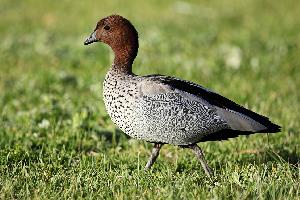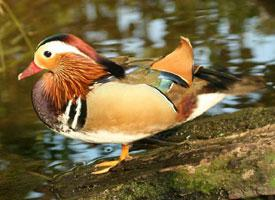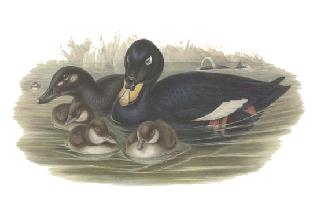
Poids et mesures
| Longueur | de 45 à 51 cm |
|---|
Description de l'animal
The Australian wood duck, scientifically named Chenonetta jubata, is a unique species of waterfowl native to Australia. It is also commonly known as the maned duck or maned goose, although it is not a true goose but rather a member of the duck family Anatidae. This medium-sized bird is distinctive in both its appearance and behavior, making it a fascinating subject for bird enthusiasts and naturalists alike.In terms of physical attributes, the Australian wood duck stands out with its robust body and broad wings. Males and females exhibit sexual dimorphism, meaning they can be distinguished by their different physical characteristics. The male wood duck boasts a dark brown head adorned with a shaggy mane, which is where the term "maned" duck derives from. Its cheeks are streaked with black, and it has a lighter gray-brown body with black mottling. The male's underparts are a paler shade, often a light beige or gray, providing a striking contrast to its darker back and wings.
The female, on the other hand, is generally less colorful than the male, with a brownish body patterned with white speckles. She has two white stripes running across her face—one from the eye to the back of the head and another below the eye. These facial markings, combined with her white-speckled breast, make her easily distinguishable from the male.
One of the most intriguing aspects of the Australian wood duck is its habitat preference. Unlike many other ducks that favor wetlands and open water, the wood duck is often found in grasslands, open woodlands, and even urban parks and gardens. It has adapted to a terrestrial lifestyle, foraging on the ground for grasses, herbs, clover, and occasionally insects, which comprise the bulk of its diet.
Australian wood ducks are also known for their strong pair bonds. They are monogamous and often mate for life, with pairs staying together throughout the year. During the breeding season, which typically ranges from September to November, the female lays a clutch of 9 to 11 creamy-white eggs in a tree hollow or a similar sheltered location. Both parents are involved in rearing the young, which are precocial and able to leave the nest shortly after hatching.
In terms of vocalizations, the Australian wood duck is less vocal than many other duck species, but it does emit a characteristic "whistle" sound, especially during the breeding season. The male's call is a subtle, rising whistle, while the female produces a more pronounced, drawn-out "quack."
The conservation status of the Australian wood duck is considered to be of least concern. The species has adapted well to human-altered landscapes and is relatively widespread and common throughout its range. However, they are still subject to threats from habitat loss and predation.
Overall, the Australian wood duck is a resilient and adaptable bird that adds to the rich tapestry of Australia's avian biodiversity. Its unique lifestyle, striking appearance, and the intriguing behaviors make it a beloved species among birdwatchers and a valuable part of the ecosystem it
Animaux similaires
Nouvelles photos d'animaux
Top 10 des animaux
- Dolphin gull (Leucophaeus scoresbii)
- Diana monkey (Cercopithecus diana)
- Moustached guenon (Cercopithecus cephus)
- Galápagos tortoise (Geochelone nigra complex)
- Japanese macaque (Macaca fuscata)
- Russian tortoise (Testudo horsfieldii)
- Stone loach (Barbatula barbatula)
- Greek tortoise (Testudo graeca)
- Common flying dragon (Draco volans)
- Vendace (Coregonus albula)


